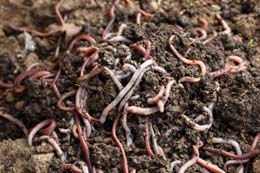Vermiculture, commonly known as worm composting, is the method of using earthworms in the production of manure. The manure is known by different names such as worm castings, humus, and vermicast.

The method of preparing humus is also called vermicomposting. The castings obtained from worms are rich in organic nutrients, and it is used both on a large scale in farming and on a small scale in home gardens. This process is practiced on a large scale in countries like Italy, Canada, Japan, the United States, and the Philippines. It can also be done on a small scale using containers made of wood, rubber, metal, or plastic.
Vermicomposting System
It is good to have a vermiculture bin at home for providing plants with the necessary fertilizers. Preparing one is easy, and can be done through the following procedure.
Materials
The materials used for the preparation of humus are a suitable container, newspaper shreds or peat moss, organic material, vegetables that are not composted, water, and earthworms. The earthworms selected for this should be in the proportion of 0.45 kg per square foot. The material used as a lid for the container should be a canvas tarp, a burlap sack, or any other suitable item.
Preparation
The box selected for the worm composting system should have 3 mm holes, starting 4 inches from its bottom. The holes cater to the ventilation needs of the system. The box should be bedded with newspaper shreds. The shreds provide ventilation and act as a fibrous material necessary for the worms to survive. On the top of the newspaper shreds, a little bit of water should be sprinkled and allowed to soak for a whole day. To obtain a loamier vermicompost, one can use Canadian peat moss instead of paper shreds.
Worm Species
Selection of earthworms is also an important task in the process of worm composting. The commonly used species are the
Eisenia foetida and the
Eisenia hortensis. The
Eisenia foetida, commonly known as 'Red Wiggler', is 4 inches long, has a red body, and a yellow tail.
Eisenia hortensis is the scientific name of the earthworm called 'European Nightcrawlers'. The advantage of using the European Nightcrawlers is that they eat a lot and thus, produce fertilizers in the same proportion. However, the lower rate of reproduction is a factor that limits their use. The earthworms that need to be used should be purchased from a vendor. Just digging up the backyard soil won't give us an access to quality earthworms.
Maintenance
An important thing to be remembered in the maintenance of the vermicast bins is to keep them in an elevated position. The worms should be fed properly and on a regular basis in order to keep them healthy. Enough moisture, if maintained in the bin, leads to the healthy growth of worms. Vegetable scraps should be added to the bin every week to nourish them. The food that is added to the bin should be in small proportions, but on a regular basis. Excessive feeding leads to fattening of the worms, while a balanced diet helps in an increase in production.
Harvesting
The harvesting is done with the help of gloves. The mixture containing earthworms and humus should be taken out of the container and spread on a piece of paper. The paper should be kept in bright light. It makes the worms migrate towards the moist portion of the heap. The dried out humus should be separated from the earthworms as they move towards the moist area.
The procedure for the preparation of a worm compost system is simple to understand and easy to follow. Following the process and guidelines can help obtain manure that is sustainable and a rich source of nutrients for your plants.






 The method of preparing humus is also called vermicomposting. The castings obtained from worms are rich in organic nutrients, and it is used both on a large scale in farming and on a small scale in home gardens. This process is practiced on a large scale in countries like Italy, Canada, Japan, the United States, and the Philippines. It can also be done on a small scale using containers made of wood, rubber, metal, or plastic.
The method of preparing humus is also called vermicomposting. The castings obtained from worms are rich in organic nutrients, and it is used both on a large scale in farming and on a small scale in home gardens. This process is practiced on a large scale in countries like Italy, Canada, Japan, the United States, and the Philippines. It can also be done on a small scale using containers made of wood, rubber, metal, or plastic.